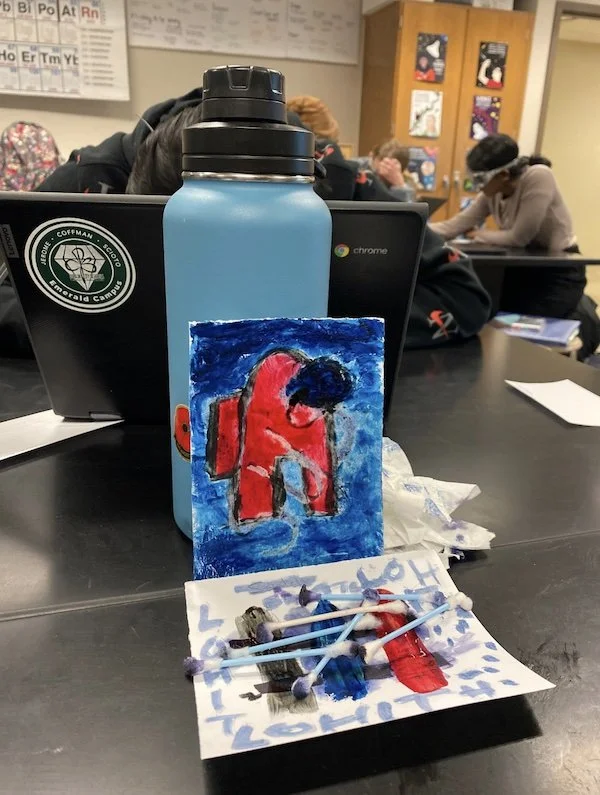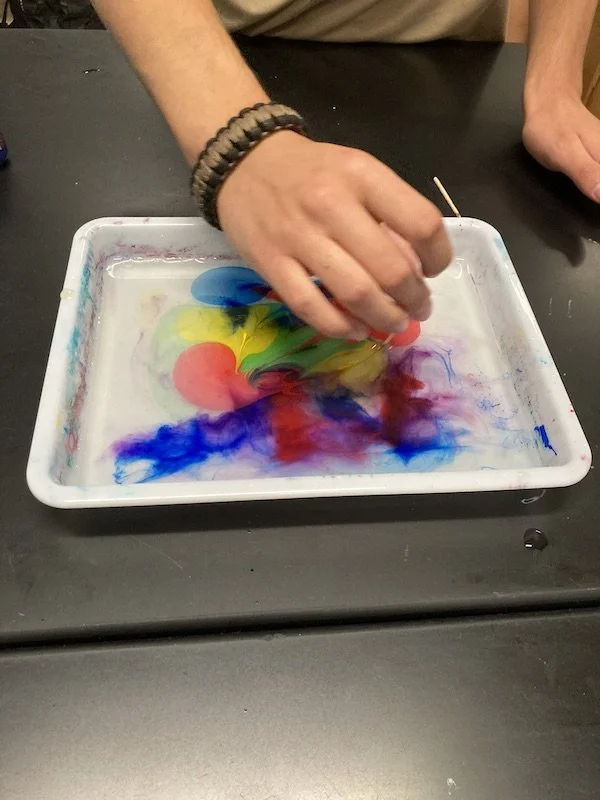Art as a Tool to Teach Chemistry
Students and teachers at Dublin Jerome and Buckeye Valley high schools experimented with art and chemistry during their high school coursework. The teachers were trained in the techniques during the summer and tried them out for the first time in their classrooms in the fall. The experiment above required a sunny day and a particular type of paper for the images to appear and did not work on the first try. “The students really enjoyed being part of something that was new to them and also new to us,” says science teacher Amy Pochodylo. “These activities made the course a lot more enjoyable for everyone.”
“We have all been teaching chemistry for awhile and there was no reason for us to change other than it would benefit our students. This project reminded me of the power of continuing to think about what’s best for students, what’s going to engage students, and then to seek out those opportunities.”
- Amy Pochodylo, Science Teacher, Dublin Jerome High School
Art and chemistry might not seem like likely companions, but for high school students in central Ohio, merging the subjects has led to increased engagement and a deeper understanding of the theoretical topics.
Many teachers strive to increase student engagement in chemistry by increasing real-world connections to difficult content. Yet, they do not have the professional development required to meaningfully achieve this, explains Joan Esson, professor and chemistry department chair at Otterbein University. Working with teachers to integrate art into chemistry labs, she believed, would open up difficult content to anxious students, improve their attitudes about science, and deepen their learning. To do so, she revised a college course she had designed called “Chemistry in Art” to align with high school standards. Then she partnered with science teachers at Dublin Jerome and Buckeye Valley high schools to pilot the curriculum in their classes.
“We know some students have a fear of science, or they believe they are not very good in science,” says Dr. Esson, who attended a National Science Foundation workshop where she learned how to incorporate art into chemistry classes at the college level. “This is a more approachable, intentional way to engage students in the chemistry classroom. I wanted to broaden that application to the high school level.”
Cleaning graffiti off a piece of artwork became a multi-day project in high school chemistry classrooms. Students learned that art restoration is a technical process and not something that is “quick and easy.”
In practice, the high school Art and Chemistry program ultimately occurred due to a handful of well-established professional partnerships. Dr. Esson connected with her colleague Dr. Paul Wendel, professor and department chair of Otterbein’s Department of Education. He contacted his former student, Amy Pochodylo. A trained chemist currently teaching science at Dublin Jerome High School, Ms. Pochodylo invited fellow teachers at Dublin Jerome and Buckeye Valley high schools to get involved.
With a grant from the Martha Holden Jennings Foundation, Drs. Esson and Wendel designed a two-day summer workshop in 2022 to introduce teachers to the new arts-integrated curriculum. During the seminar, the professors described strategies teachers could use to teach content in a visually-centered way. They demonstrated actual classroom activities teachers could implement through lab sessions that would help students understand how chemistry connects to real life. The teachers discussed how and where the activities tied into the state standards and went home with the materials necessary to complete the lab activities back at school.
“There are almost no opportunities for professional development only in chemistry,” explains Ms. Pochodylo, who holds a master’s degree in chemistry and worked in the field before pursuing a teaching degree. “After two full days of thinking about teaching chemistry and getting exposure to the new curriculum, we all walked away energized.”
During the 2022-23 school year, the teachers piloted the new activities with their students. One lab required students to make paints and then create an original work of art. Unbeknownst to them, the teachers would deface their work with an unidentified ink, leading to a lesson on removing graffiti without destroying the original piece. “The process of cleaning art is rooted in many chemical principles,” explains Ms. Pochodylo. “They had to think about what the graffiti ink is made of and then run tests to figure out the best technique to clean it. It’s all about chemical structure and the interactions between chemicals, and it fits in perfectly with our curriculum.”
“I was on hand during one of the graffiti days and heard really rich conversations among the students,” adds Dr. Wendel, who periodically visited classrooms to observe the curriculum in action. “This project has allowed for a lot of discovery in a chemistry classroom, which to me is the most challenging environment for discovery learning. I was very impressed by what the high school students are capable of doing in chemistry.”
.Art activities invigorated learning in the chemistry classroom.
The participating science teachers formed a professional learning community and remained in contact throughout the school year as they tried out different art activities in their “real world” classrooms. “Overall, it was super invigorating for us to have chemistry-specific professional development time,” Ms. Pochodylo comments. “We attempted to figure out the sticking points: what students struggle with, what works well, and what does not work well with a class of 30 students. We had professional conversations that went far beyond what will be on the next test. It has been very valuable to have something we are trying for the first time and working through it together.”
With a school year of success behind them, Ms. Pochodylo says the teachers have been talking about how they will incorporate the labs into their coursework next year in ways that are more engaging for their students.
“This curriculum allowed us to conduct labs that are more meaningful, that increase content knowledge, and are super engaging for the students,” she continues. “It has reminded me of how important it is for teachers to learn and grow, especially when the outcome is what’s best for kids.”
“Through our research,” adds Dr. Wendel, “we’re hoping to show that when students engage in these activities, they are more excited about chemistry and can see more clearly the connection between chemistry and their everyday lives.”




